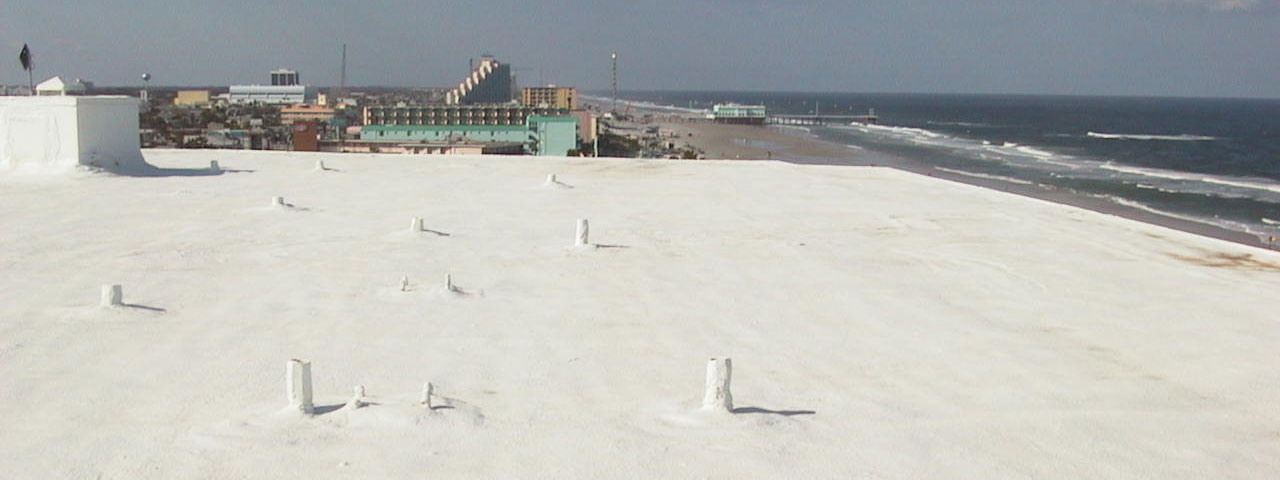ENERGY STAR certified Cool Roof Coatings

Minneapolis
Qualified roof coating products that have ENERGY STAR (DOE) certification can reduce energy bills by up to 50% while reducing the air conditioning that's needed in buildings. Certain standards for emissivity in roof coating systems, solar reflectance, and 3-year aged maintenance of reflectivity are defined in The Cool Roof Program. Emissivity is measured in the percentage of heat a roof lets out of a building, and reflectivity is the percentage amount of the sun's heat that a roof keeps off a building.
The temperature of the roof can be lowered by up to 100 degrees F with white or light colored roof coatings that reflect the sun's UV rays and heat.
White/light colored coatings are most commonly used for cool roof applications over spray polyurethane foam and other roof deck surfaces. These light colored coating can be: silicone, polyurea, acrylic, urethanes.
During warmer summer months, temperatures can reach 170 degrees F on a low-slope black asphalt roof, and they can drop to -20 degrees F during the winter in northern and higher elevated regions. In higher elevated regions in the North, temperatures can drop to -20 degrees during the winter. During the summertime, temperature can reach 170 degrees F on a low-slope black asphalt roof. Heat can have significant adverse effects on energy consumption when ultraviolet radiation is transferred into the interior of a building.
Islands / Heat Zones in Urban Areas
A positive environmental impact can be gained by installing Cool Roofs in cities. Urban Heat Zones are caused in part by a significant number of large dark colored roofs in urban areas that can reach extremely high temperatures. There is a significant large, dark-colored roofs in urban areas, and because they can reach extremely high temperatures, they are part of the reason Urban Heat Zones are caused. Increased heat consumption can be caused by this macro heat effect from hot buildings and pavement. It can also cause smog to generate and, not to mention, discomfort to building occupants. Building owners who install cool roofs are getting utility discounts and rebates in certain states, which means that a cool roof can help save money and the environment at the same time.
Specifications & Approvals
In order to predict whether one product will perform better than the other, one cannot simply look into two pails of roof coating to obtain the answer. A yardstick that can measure all liquid-applied roof coatings is only established after following specific guidelines, including testing and approval of the materials. Information on whether the material meets these specific standards is usually displayed on the label of the product.
When looking to meet a specific needs, facility managers and owners should look for such label markings. It is usually indicated in the markings whether a coating has the approval of certifying testing organizations or whether it meets specific standards.
American Society for Testing and Materials (ASTM) D 6083 is one of the most important standards. Testing the coating against specific physical characteristics for elongation, accelerated weathering after testing for 1,000 hours, tensile strength, water swelling, tear strength, adhesion, elongation, low-temperature flexibility, and elongation is measured by the standard. The standard also measures physical performance. Managers and owners are usually lead to an excellent product if this comprehensive set of standards is met.

How can a SPF roof system improve your traditional roof system?
- Leak-free monolithic seal
- Self-flashing
- High insulation value
- Rapid payback with energy savings
- Strong adhesion
- Wind uplift resistance
- Weather resistant
- Lightweight and high strength
- UL and FM approved systems
Navigation
Areas of SERVICE
Our Minneapolis spray foam contractors provide high-quality spray foam insulation services for residential and commercial applications and foam roofing services for industrial and commercial buildings near and throughout Minnesota. We offer competitive spray foam insulation pricing in MN and ultimately help you save money on utility bills.
Call us today at for a free quote or estimate.
